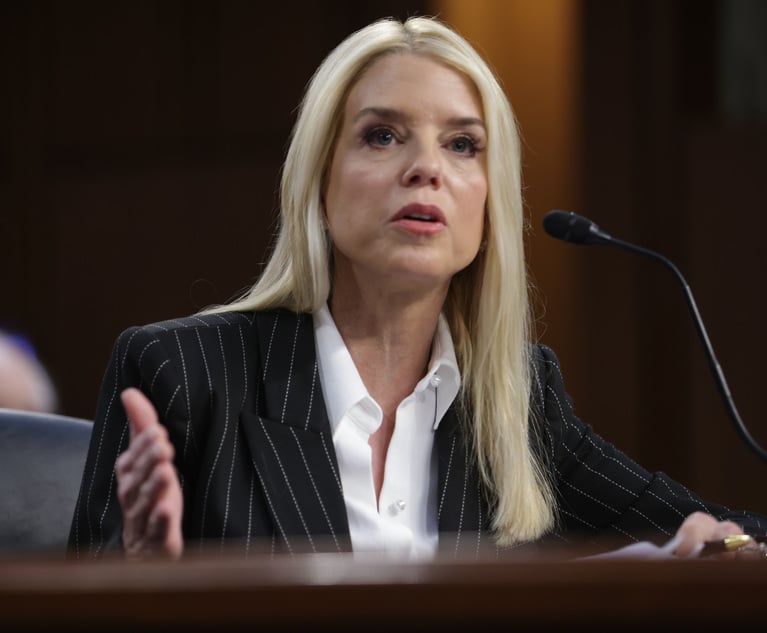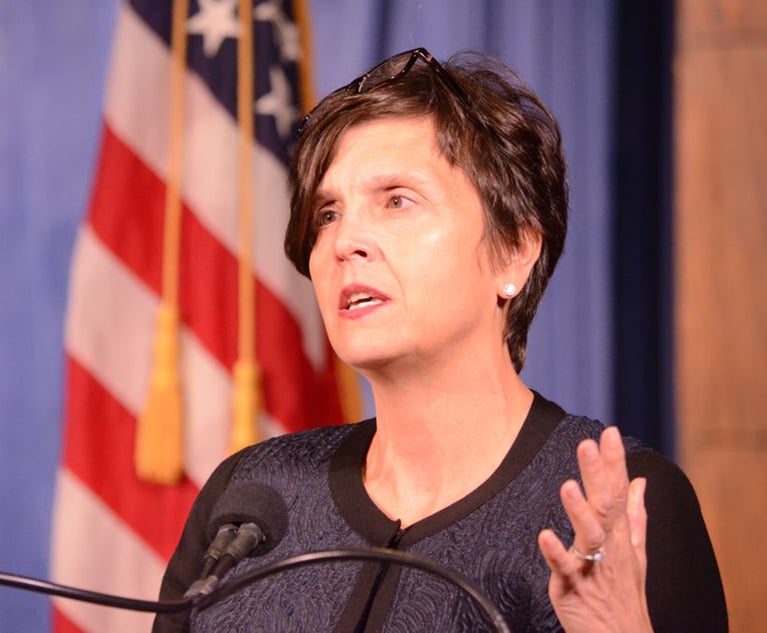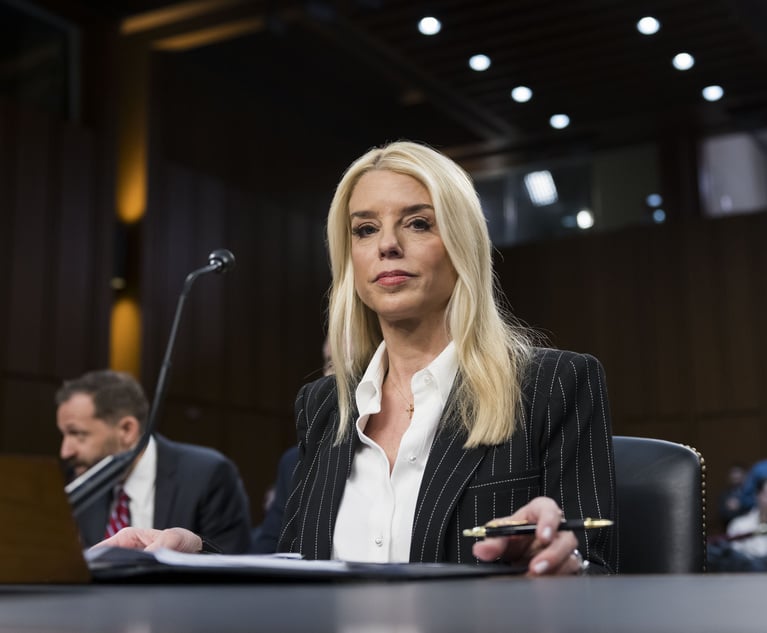Paycheck Protection Program Leaves Restaurant Industry With Questions
The CARES Act is a step in the right direction, but for many restaurant companies, financial relief is still out of reach.
April 17, 2020 at 02:34 PM
6 minute read
 A street full of restaurants and pubs is shut down during the coronavirus pandemic. Photo: Ryland West/ALM
A street full of restaurants and pubs is shut down during the coronavirus pandemic. Photo: Ryland West/ALM
Restaurant companies have been devastated by the COVID-19 pandemic. The National Restaurant Association estimates that the industry has already lost more than 3 million jobs and $25 billion in sales, and there are many more dark days ahead. The sweeping $2 trillion Coronavirus Aid, Relief, and Economic Security (CARES) Act includes special provisions designed to assist restaurant companies and their employees. It amends Section 7(a) of the Small Business Act to make forgivable and tax-free Paycheck Protection Program loans of up to $10 million available to "small businesses" and certain larger businesses that fall under North American Industry Classification System (NAICS) Sector 72, which defines "Accommodation and Food Services," such as restaurants.
A great debate has been raging among lawyers since the Paycheck Protection Program details have been available about whether the SBA affiliation rules apply to NAICS Sector 72 companies. The affiliation rules require that companies be "affiliated" with their owners with positive or negative control (as defined in the SBA affiliation rules), and with other companies controlled by those owners, and that the size test be applied on a combined basis to all affiliated entities. This often results in the combined entity not meeting the size test for a "small business" and therefore being ineligible for an SBA loan.
The CARES Act states that "any business concern that employs not more than 500 employees per physical location of the business concern and that is assigned a North American Industry Classification System code beginning with 72 … shall be eligible to receive a covered loan."
This seems to say that if a restaurant company has fewer than 500 employees in a single location, then it is eligible to receive a PPP loan. However, the legislation goes on to say that "the provisions applicable to affiliations … are waived with respect to eligibility for a covered loan for any business concern with not more than 500 employees that, as of the date on which the covered loan is disbursed, is assigned a [NAICS] code beginning with 72."
The single location language isn't included in the latter section. This means the affiliation rules are waived for NAICS 72 employers that have 500 or fewer employees; and, conversely, they are not waived for NAICS 72 employers that have more than 500 employees. If Congress intended for all restaurant companies to be eligible for PPP loans, additional guidance confirming that needs to be provided.
A workaround exists for restaurant companies with operating subsidiaries that have their own Federal Employer Identification Number and their own separate workforce, particularly if the subsidiaries file payroll tax returns separately: have each operating subsidiary with fewer than 500 employees apply independently. The SBA affiliation rules won't apply to them. Affiliation rules are also fully waived for restaurant franchisees whose concepts are listed on the SBA's franchise identifier list.
Application of the SBA affiliation rules can be particularly problematic for restaurant companies with private equity owners. PE and other owners can irrevocably waive control rights over portfolio companies to avoid affiliation, but this is not a viable solution for many. However, an applicant is not disqualified just because it must be affiliated with other entities; it depends on the facts. For instance, if the affiliated companies are all in Sector 72 and none has more than 500 employees per location, then the applicant (and the affiliates) would each be eligible. Under this standard, even some publicly traded restaurant companies may meet the size test. But if any of the Sector 72 affiliates has more than 500 employees in a single location, none of the companies would qualify.
Another open issue relates to timing on the most attractive element of PPP loans: forgiveness. If an applicant asks for the maximum loan amount, it will receive 2.5 times its aggregate payroll costs based on the number of employees it had during calendar 2019 or the 12 months immediately preceding the application date (or during other designated periods for seasonal or newly formed businesses), up to a maximum of $10 million. The loan amount is designed to cover payroll based on the borrower's full number of employees as calculated pre-COVID-19, plus an additional 25% that can be used for rent, mortgage interest and utilities. At least 75% of the PPP loan proceeds must be used for payroll, and the full amount of the PPP is supposed to be used by June 30, with any portion to be forgiven being used within eight weeks of receipt. If a borrower has fewer employees when it receives the loan than it had during the period used to calculate the loan amount, the loan proceeds will not be able to be used for the intended/permitted purposes within the specified time period.
The SBA's Interim Final Rule states that the amount forgiven will be reduced proportionally by any reduction in employee count as compared to the prior year, and by any reduction in employee pay beyond 25% of the prior year's compensation. Borrowers who rehire employees previously laid off due to the COVID-19 crisis—and restore their full wages—by June 30 will not be penalized for having reduced payroll at the beginning of the period. But if a borrower is unable to rehire its workforce by June 30, it won't be able to take full advantage of the loan forgiveness feature—and it is very possible that restaurants will not be able to restore full service by June 30, either due to continued shut-down orders or due to people's fear. Further complicating matters, many hourly employees may not want to return to work until the coronavirus is truly conquered, especially given the emergency increase in unemployment benefits of $600 per week made available under the CARES Act (which, not coincidentally, equals a wage of $15 per hour times 40 hours per week, a typical full wage for a restaurant worker).
To best assist restaurant companies, Congress or the SBA needs to allow the PPP loan proceeds to be used and forgiven over a longer period of time, or allow restaurants to defer receipt of the loans until they have reopened and rehired their workforce so they can use the proceeds within an expanded forgiveness period. A bigger and related issue is that the PPP loan pool is almost depleted. Although businesses were supposed to have been able to apply for PPP loans through June 30, which would have alleviated some of the time pressure to reopen and rehire workers, much of the $349 billion allocated to the program has already been claimed.
Congress and the Treasury Department need to work together to correct these issues and provide significant additional funds in order to accomplish the lofty goals of the PPP.
Anna M. Graves, a partner at Pillsbury Winthrop Shaw Pittman, is co-leader of the firm's restaurant, food and beverage industry group. She handles complex M&A transactions, private offerings, joint ventures, and startup structuring and financing.
This content has been archived. It is available through our partners, LexisNexis® and Bloomberg Law.
To view this content, please continue to their sites.
Not a Lexis Subscriber?
Subscribe Now
Not a Bloomberg Law Subscriber?
Subscribe Now
NOT FOR REPRINT
© 2025 ALM Global, LLC, All Rights Reserved. Request academic re-use from www.copyright.com. All other uses, submit a request to [email protected]. For more information visit Asset & Logo Licensing.
You Might Like
View All
Skadden and Steptoe, Defending Amex GBT, Blasts Biden DOJ's Antitrust Lawsuit Over Merger Proposal
4 minute read
'Lack of Independence' or 'Tethered to the Law'? Witnesses Speak on Bondi
4 minute read
Law Firms Mentioned
Trending Stories
- 1South Florida Attorney Charged With Aggravated Battery After Incident in Prime Rib Line
- 2'A Death Sentence for TikTok'?: Litigators and Experts Weigh Impact of Potential Ban on Creators and Data Privacy
- 3Bribery Case Against Former Lt. Gov. Brian Benjamin Is Dropped
- 4‘Extremely Disturbing’: AI Firms Face Class Action by ‘Taskers’ Exposed to Traumatic Content
- 5State Appeals Court Revives BraunHagey Lawsuit Alleging $4.2M Unlawful Wire to China
Who Got The Work
J. Brugh Lower of Gibbons has entered an appearance for industrial equipment supplier Devco Corporation in a pending trademark infringement lawsuit. The suit, accusing the defendant of selling knock-off Graco products, was filed Dec. 18 in New Jersey District Court by Rivkin Radler on behalf of Graco Inc. and Graco Minnesota. The case, assigned to U.S. District Judge Zahid N. Quraishi, is 3:24-cv-11294, Graco Inc. et al v. Devco Corporation.
Who Got The Work
Rebecca Maller-Stein and Kent A. Yalowitz of Arnold & Porter Kaye Scholer have entered their appearances for Hanaco Venture Capital and its executives, Lior Prosor and David Frankel, in a pending securities lawsuit. The action, filed on Dec. 24 in New York Southern District Court by Zell, Aron & Co. on behalf of Goldeneye Advisors, accuses the defendants of negligently and fraudulently managing the plaintiff's $1 million investment. The case, assigned to U.S. District Judge Vernon S. Broderick, is 1:24-cv-09918, Goldeneye Advisors, LLC v. Hanaco Venture Capital, Ltd. et al.
Who Got The Work
Attorneys from A&O Shearman has stepped in as defense counsel for Toronto-Dominion Bank and other defendants in a pending securities class action. The suit, filed Dec. 11 in New York Southern District Court by Bleichmar Fonti & Auld, accuses the defendants of concealing the bank's 'pervasive' deficiencies in regards to its compliance with the Bank Secrecy Act and the quality of its anti-money laundering controls. The case, assigned to U.S. District Judge Arun Subramanian, is 1:24-cv-09445, Gonzalez v. The Toronto-Dominion Bank et al.
Who Got The Work
Crown Castle International, a Pennsylvania company providing shared communications infrastructure, has turned to Luke D. Wolf of Gordon Rees Scully Mansukhani to fend off a pending breach-of-contract lawsuit. The court action, filed Nov. 25 in Michigan Eastern District Court by Hooper Hathaway PC on behalf of The Town Residences LLC, accuses Crown Castle of failing to transfer approximately $30,000 in utility payments from T-Mobile in breach of a roof-top lease and assignment agreement. The case, assigned to U.S. District Judge Susan K. Declercq, is 2:24-cv-13131, The Town Residences LLC v. T-Mobile US, Inc. et al.
Who Got The Work
Wilfred P. Coronato and Daniel M. Schwartz of McCarter & English have stepped in as defense counsel to Electrolux Home Products Inc. in a pending product liability lawsuit. The court action, filed Nov. 26 in New York Eastern District Court by Poulos Lopiccolo PC and Nagel Rice LLP on behalf of David Stern, alleges that the defendant's refrigerators’ drawers and shelving repeatedly break and fall apart within months after purchase. The case, assigned to U.S. District Judge Joan M. Azrack, is 2:24-cv-08204, Stern v. Electrolux Home Products, Inc.
Featured Firms
Law Offices of Gary Martin Hays & Associates, P.C.
(470) 294-1674
Law Offices of Mark E. Salomone
(857) 444-6468
Smith & Hassler
(713) 739-1250











